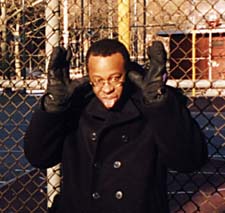|
Before we get to Nu
Bop, let's take a quick but instructive look at
another disc that was released last year. David S. Ware
turned a few heads by recording Corridors And Parallels,
on which Matthew Shipp, the pianist in Ware's longstanding
quartet, forsook his piano for a Korg synthesizer. To
these ears, it wasn't a wholly successful venture; Shipp's
facility on the instrument often sounded like an adept
pianist exploring the settings on his new electronic axe
for the first time, and the band as a whole failed to
gel with the same magic they'd exhibited in the past.
But the album sent out a signal that the leading lights
of New York's free jazz scene were starting to incorporate
new sounds into their ever-evolving music, which in itself
was noteworthy; after all, hasn't jazz always been a continual
exploration?
 |
Enter Nu Bop. Shipp
has gone back to piano. William Parker and Guillermo E.
Brown, the Ware quartet's rhythm section, are on board.
Daniel Carter –best known for his Ornettish, freely
melodic playing with Test and Other Dimensions In Music–handles
saxophone (and flute) duties. Rounding out the group is
Chris Flam, who's previously worked with DJ Spooky and
A Guy Called Gerald, on synths and programming. Is the
word "fusion" leaping to mind? Banish it now. There's
no laid-back noodling, tepid Fender Rhodes workouts, or
dilution of vision. Shipp is consciously trying to forge
a new synthesis here, and the results sometimes verge
on the spectacular. The album starts off strong: "Space
Shipp"—with which Shipp joins the venerable ranks
of jazzmen who can't resist punning on their names in
titles—announces the new breed with Flam's turntable/synth
scrapings and Brown's up-front drumming, and Shipp hits
the right blend of hard funk and free playing. On "Nu-Bop,"
Shipp lays out, and Parker's enormous bass is given the
spotlight in the mix (who needs to plug in when your sound
is as gargantuan as Parker's?); Daniel Carter's ethereal
alto is relatively buried, but in a way that suits the
composition, rather than calling the producers' judgment
into question. "ZX-1" drops the electronics—and the
rest of the band—as Shipp takes a solo turn at the
piano; leaving the driving rhythms aside momentarily,
he unwinds a meditative, minor-key piece. "D's Choice"
(D? Daniel? Good pick, man, even if you're not on the
track) is a trio meeting of Shipp, Brown and Flam. There's
no flashy solo here; a jazz purist would probably describe
Shipp's adherence to the melody line as mere comping.
But let's leave the purists at the door, and call it for
the great track that it is. On "X-Ray," Carter picks up
his flute to duet with Parker; it's a rare opportunity
to hear the avowedly in-the-moment Carter play a pre-composed
piece. Again, there's little flash; Carter stays in the
flute's middle register, dextrously spiralling within
the song's parameters. "Rocket Shipp" (whose title, like
"Space Shipp," gives
a nod to a Sun Ra—a pioneer of electronics in jazz,
and a self-proclaimed outer space visitor) mines the same
funky/free vein as the leadoff track. Brown was virtually
unknown before joining Ware's band. If his muscular style,
with his tendency towards hard backbeats, has perhaps
lowered the bar that his predeccessor (the more expansive
Susie Ibarra) had set with that group, it's right at home
here; he keeps the rhythm going during Shipp's hyper-articulated
keyboard runs, and pumps the beat even stronger when the
pianist goes back to pounding out the melody. The song
ends falteringly, and there's a bit of enthusiastic studio
chatter from Parker: "I'm getting into it now, man...
gimme some more!" His request is granted with the next
cut, "Select Mode 1," which just begs to be extended beyond
its 1:23 running time, pressed onto a 12" single, and
sent out to dance club DJs across the country. It's followed
by "Nu Abstract," on which Brown sits out, giving way
to a wedding of Flam's synth textures and Parker's arco
bass, over which Shipp plucks out a gentle, uneasy melody.
The album closes with "Select Mode 2," another charging
track with an odd time signature. If I have any complaints
at all, it's that the talents of Daniel Carter were only
utilized on two of the nine cuts. But that's merely a
wish for more good stuff, and what Shipp has served up
here is a texturally varied, forward-looking, and rousing
album.
-
James
Lindbloom
|